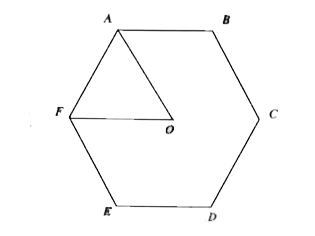If ABCDEF is regular hexagon, then AD+EB+FC is
2A→B
→0
3A→B
4A→B
The correct Answer is:D
Let A→B=→aandB→C=→b. Then ,
A→O=B→C=→b,O→C=F→O=→a

In ΔAOB, we have
A→B+B→O=A→O
⇒→a+B→O=→b [∵A→O=B→C=→b]
⇒B→O=→b−→a
⇒B→E=2B→O=2(→b−→a)
∴A→D+E→B+F→C=A→D−B→E+2O→C
⇒A→D+E→B+F→C=2→b−2(→b−→a)+2→a=4→a=4A→B
Topper's Solved these Questions
- BOOK - OBJECTIVE RD SHARMA ENGLISHCHAPTER - ALGEBRA OF VECTORSEXERCISE - Exercise30videos
ALGEBRA OF VECTORS
- BOOK - OBJECTIVE RD SHARMA ENGLISHCHAPTER - ALGEBRA OF VECTORSEXERCISE - Chapter Test30videos
ALGEBRA OF VECTORS
- BOOK - OBJECTIVE RD SHARMA ENGLISHCHAPTER - ALGEBRAIC INEQUATIONSEXERCISE - Exercise39videos
ALGEBRAIC INEQUATIONS
Similar Questions
Knowledge Check
- Question 1 - Select One
In the figure shown, ABCDEF is a regular hexagon and AOF is an equilateral triangle. The perimeter of ΔAOF is 2a feet. What is the perimeter of the hexagon in feet?
 A2aB3aC4aD6a
A2aB3aC4aD6a
If ABCDEF is a regular hexagon then −−→AD+−−→EB+−−→FC equals :
View SolutionIf ABCDEF is a regular hexagon with −−→AB=→a and −−→BC=→b, then −−→CE equals
View SolutionIf ABCDEF is a regular hexagon, prove that AD+EB+FC=4AB.
View SolutionABCDEF is a regular hexagon with centre a the origin such that −−→AB+−−→EB+−−→FC=λ−−→EDthenλ= (A) 2 (B) 4 (C) 6 (D) 3
View SolutionIf ABCDEF is a regular hexagon, prove that −−→AC+−−→AD+−−→EA+−−→FA=3−−→AB
View SolutionABCDEF is a regular hexagon where centre O is the origin, if the position vector of A is ˆi−ˆj+2ˆk, then ¯¯¯¯¯¯BC is equal to
View SolutionABCDEF is a regular hexagon , with the sides AB, AC, AD, AE and AF representing vectors 1 unit , 2 units , 3 units , 4 units and 5 units respetively . Find their resultant ?
View Solution

